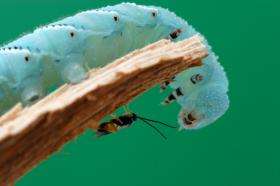Research on viral origins suggests new definition of virus may be needed

(�鶹��ԺOrg.com) -- The strange interaction of a parasitic wasp, the caterpillar in which it lays its eggs and a virus that helps it overcome the caterpillar’s immune defenses has some scientists rethinking the definition of a virus.
In an essay in the journal Science, Donald Stoltz, a professor of microbiology and immunology at Dalhousie University, in Halifax, Nova Scotia, and James Whitfield, a professor of entomology at the University of Illinois, report that a new study also appearing in Science shows how the diverse ways in which viruses operate within and among the organisms they encounter may not be fully appreciated. The study, from a team of researchers led by the Université François Rabelais, in Tours, France, found that the genes that encode a virus that helps wasps successfully parasitize caterpillars are actually integrated into the wasps’ own chromosomes. These genes, which they show to be related to those from another known group of viruses, are an indivisible part of the wasp’s genetic heritage; they are passed down from one generation to another of parasitoid wasps.
While it is not unusual for virus DNA to become embedded in the chromosomes of their hosts, in this case the wasp is not the only “host” of the virus. The viral genes do replicate (copy themselves) inside the wasp (the permanent host), but they actually target - and act upon - the immune system of the caterpillar (a more transient host).
“The unique thing about these viruses is that the organism into whose DNA their genes are embedded in is not the same one that their genes are actually targeted to operate on,” Whitfield said. “So it’s sort of like having two hosts, except that there’s not a complete life cycle in either host.”
The virus is beneficial to the wasp and depends on the wasp for its own survival, suggesting a kind of obligate mutualism that is not normally seen in viruses, Whitfield said.
Researchers have known for about 40 years that some species of parasitoid wasps inject these viruses, known as polydnaviruses, into the body cavities of caterpillars at the same time that they lay their eggs in the caterpillars. Because these “virus-like particles” have become an integral part of the wasp genome, some researchers have suggested they should no longer be considered viruses.
“It’s true that the wasp DNA and the viral DNA are now combined into the same genome, so maybe it’s not productive to think of them as separate entities,” Whitfield said. “But on the other hand, if you really want to understand them well, it does help to know where things come from.”
Whitfield and Stoltz have each spent decades studying the interplay of parasite and pathogens that makes up the life cycle of the parasitoid wasps. In their essay, they suggest that taxonomists of viruses take a new look at how viruses are defined.
“Many virology texts won’t even mention polydnaviruses,” Whitfield said. “The issue we bring up is: Do we want to call these viruses? And if not, why not? Because they certainly started out as viruses. And if so, then we have to change the definition of viruses to somehow specify what it is that a virus has to contain, and what it has to do, to be considered a virus.”
Provided by University of Illinois at Urbana-Champaign















